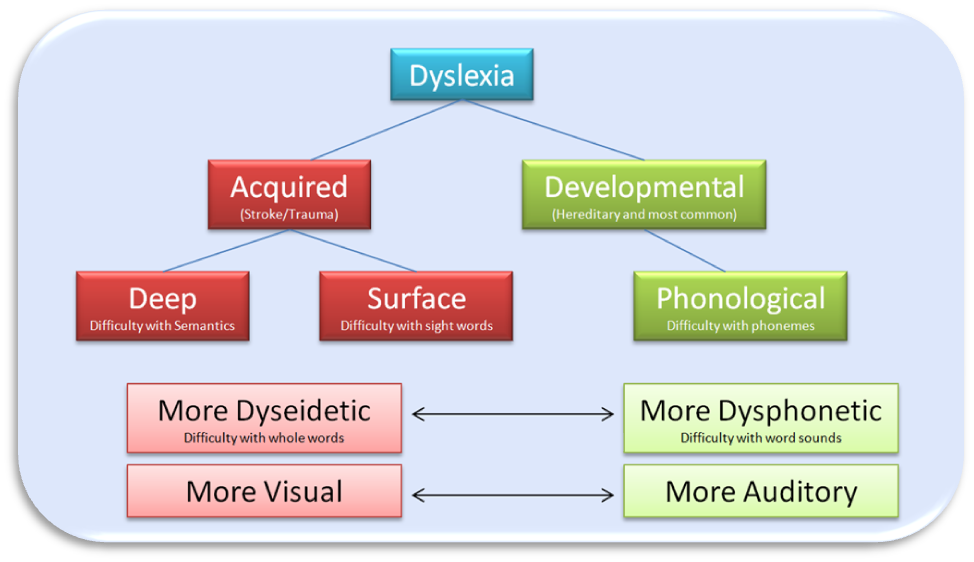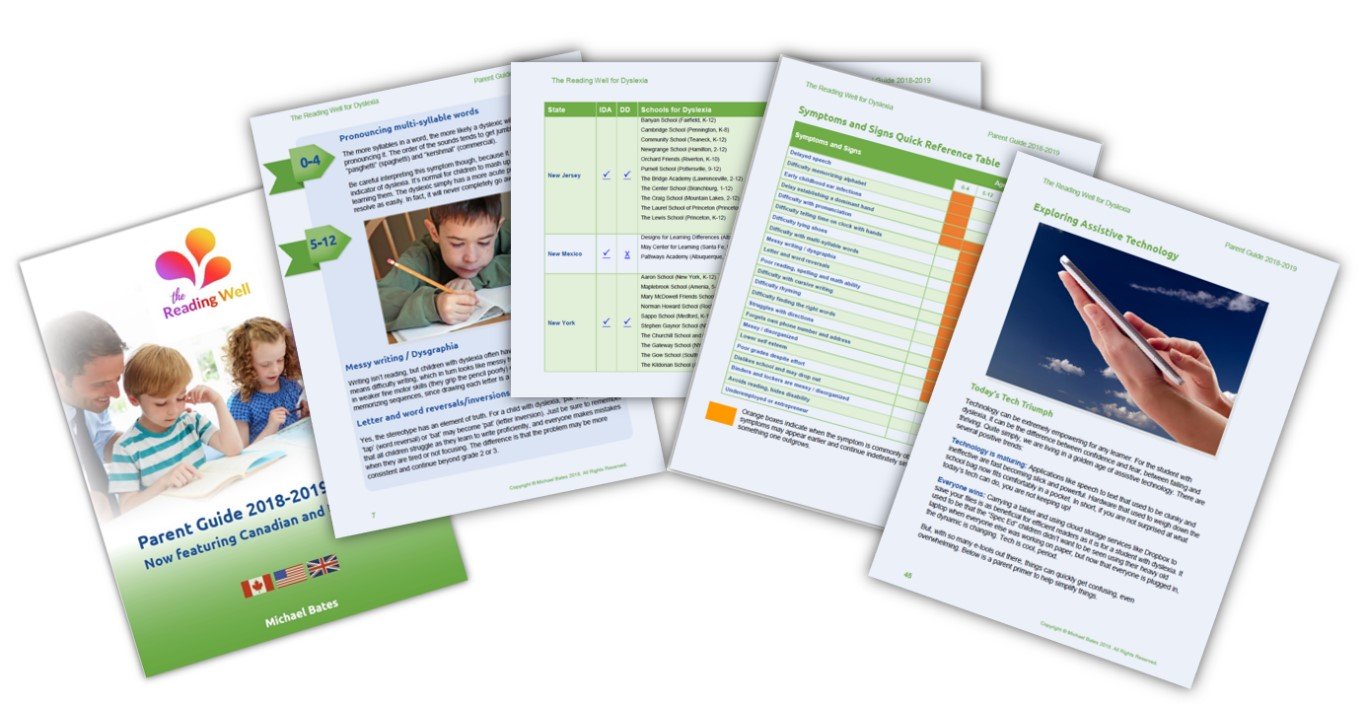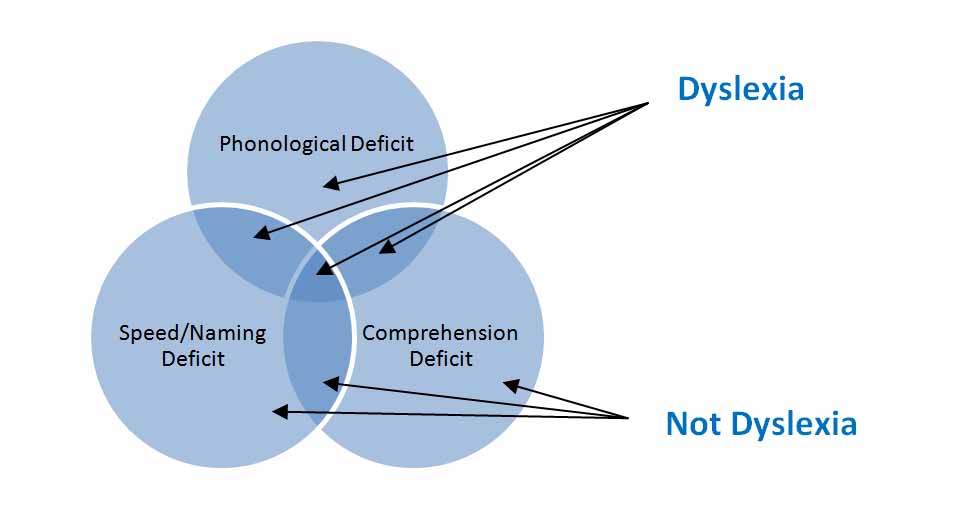Types of Dyslexia
Exploring Different Types of Dyslexia
Are there different types of dyslexia? If there are, they might require different kinds of interventions. This suggests it is important we identify any varieties that might exist. As a first step, consider the Venn diagram below that breaks out reading disabilities by deficit. About 20% of people have a reading disability and they fall somewhere in the three blue circles depending on their deficits.
The different combinations of deficits confirms that struggling readers will likely require some personalized interventions. But differences within the phonological deficit circle alone, which we explore below, add further to the complexity.
Types of Reading Disabilities
- Phonological Deficit
Difficulty decoding or assembling words based on their sounds. Note that phonemic awareness is not a reading deficit per se since it involves only sounds and not letters. - Speed/Naming Deficit
Slow reading; poor use of sight words. A sight word is a word that is instantly recognized by the reader; is not sounded out, and requires almost no effort to understand. - Comprehension Deficit
Poor understanding of what was just read.
The Bottom Line
All varieties of dyslexia involve a significant phonological deficit, regardless of whether there is a comprehension or speed deficit. In practice, most people with dyslexia have at least two deficits.
See our What is Dyslexia page for more detail.
But
people with severe reading disabilities aren't randomly distributed
across the three deficit circles. A whopping 80% have a phonological deficit and fall in the top bubble. These are the ones
we would call dyslexic. They typically have difficulty discriminating and manipulating phonemes, lacking the ability to easily decode or assemble words based on their
constituent sounds.
About 20% of those with reading disabilities have speed and/or comprehension
problems but can sound out words without difficulty - they technically don't have dyslexia
but will need reading help, just a different kind of help. See the Dyslexia Treatment page for more details on the specific kinds of help.
Vanilla, Chocolate, Strawberry and Rocky Road Dyslexia?
Can we divide the group of people who
are in the top bubble further into more specific dyslexia types? Are
there 101 flavours? The short answer is yes, there are different types
and these types do have some implications for treatment.Unfortunately, academics and researchers identify and define more types of dyslexia than parents and teachers can keep track of. Further, many websites define different types incorrectly or discuss types which are not widely recognized at all.
Below is a taxonomy of only the most commonly recognized and discussed types of dyslexia.
Subtypes of Dyslexia

By Sensory
System
By
Deficit
By Time of
Onset
Non Reading
Types
Acquired Dyslexia
Click on each type above for more details. A short description is provided below.
By Sensory System:
Auditory dyslexia involves difficulty processing sounds of letters or groups of letters. Multiple sounds may be fused as a singular sound. For example the word 'back' will be heard as a single sound rather than something made up of the sounds /b/ - /aa/ -/ck/. Single syllable words are especially prone to this problem.
Visual dyslexia is defined as reading difficulty resulting from vision related problems. Though the term is a misnomer, visual problems can definitely lead to reading and learning problems.
Attentional Dyslexia
A 2010 study from Tel Aviv University in Israel found a type of dyslexia they call attentional dyslexia in which children identify letters correctly, but the letters jump between words on the page. 'kind wing' would be read as 'wind king.' The substitutions are not caused by an inability to identify letters or convert them to sounds, but instead result from the migration of letters between words—the first letter of one word switches place with the first letter of another word.
By Deficit
Phonological dyslexia is extreme
difficulty reading that is a result of phonological impairment, meaning
the ability to manipulate the basic sounds of language. The individual sounds of language become
'sticky', unable to be broken apart and manipulated easily.
According to Nancy Mather and Barbara Wendling in their excellent 2012 book Essentials of Dyslexia Assessment and Intervention, surface dyslexia is:
"A type of dyslexia characterized by difficulty with whole word recognition and spelling, especially when the words have irregular spelling-sound correspondences."
Deep dyslexia is an acquired form of dyslexia, meaning it does not typically result from genetic, hereditary
(developmental) causes. It represents a loss of existing capacity to
read, often because of head trauma or stroke that affects the left side
of the brain. It is distinguished by two things:semantic errors and difficulty reading non-words.
By Time of Onset:
Developmental dyslexia is not so much a type of dyslexia, it is dyslexia.
In fact our definition of it would be the same as our definition of dyslexia generally: Extreme difficulty reading caused by a hereditary, brain based, phonologic disability.
So why do people use the term instead of just saying dyslexia? The simple answer is they are trying to be more specific, distinguishing 'regular' dyslexia from the other types of dyslexia. In particular, distinguishing it from acquired forms of dyslexia that result from stroke or head trauma for example, which often present very differently. For more on developmental dyslexia, visit the International Dyslexia Association website.
Acquired Dyslexia
This
type results from trauma or injury to that part of the brain that controls reading and writing. Late in
life this can be the result of a tumor or stroke.
Other Dyslexia Types:
Directional dyslexia is distinguished by left-right confusion and a tendency to become disoriented or lost. The term is also occasionally used to mean confusion with letters such as p and b or d and b, where there is confusion over the 'direction' of the letter. Generally, problems with directions are a symptom of dyslexia more than a sub-type. Not all people with dyslexia have this problem.
Math dyslexia or dyscalculia is not, in fact, a type of dyslexia, but we included it here because the term is frequently used. According to the U.S. National Center for Learning Disabilities, math dyslexia, or dyscalculia, refers to a wide range of lifelong learning disabilities involving math, varies from person to person and affects people differently at different stages of life.
As with reading, when basic math skills are not mastered early, more advanced math becomes extremely difficult. Approximately half of people with dyslexia also have dyscalculia, though far less research has been conducted regarding testing, assessment and remediation.
Back to the top of Types of Dyslexia
- Home ›
- Types of Dyslexia
Image Note: (types of reading disabilities) Inspired by a similar diagram in Moats, L, & Tolman, C (2009) in Language Essentials for Teachers of Reading and Spelling (LETRS): The Challenge of Learning to Read (Module 1). Boston: Sopris West. Note that the original diagram did not include dyslexia within the framework, and the authors may or may not agree with its orientation here.


New! Comments
Share your thoughts or ideas! Leave us a comment in the box below. You can post it at this site only or on Facebook too, it's up to you.